
A minesweeper is a small warship designed to remove or detonate naval mines. Using various mechanisms intended to counter the threat posed by naval mines, minesweepers keep waterways clear for safe shipping.

A minehunter is a naval vessel that seeks, detects, and destroys individual naval mines. Minesweepers, on the other hand, clear mined areas as a whole, without prior detection of mines. A vessel that combines both of these roles is known as a mine countermeasures vessel (MCMV).

The Belgian Navy, officially the Naval Component of the Belgian Armed Forces, is the naval service of Belgium.

A mine countermeasures vessel or MCMV is a type of naval ship designed for the location of and destruction of naval mines which combines the role of a minesweeper and minehunter in one hull. The term MCMV is also applied collectively to minehunters and minesweepers.
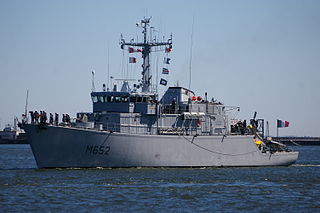
The Tripartite class is a class of minehunters developed from an agreement between the navies of Belgium, France and the Netherlands. A total of 35 ships were constructed for the three navies. The class was constructed in the 1980s–1990s in all three countries, using a mix of minehunting, electrical and propulsion systems from the three member nations. In France, where they are known as the Éridan class they are primarily used as minehunters, but have been used for minesweeping and ammunition transport in Belgium and the Netherlands, where the Tripartites are known as the Alkmaar class.
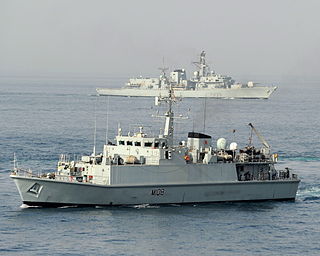
HMS Grimsby was a Sandown-class minehunter of the British Royal Navy, serving from 1999–2022, and the second ship to bear the name.
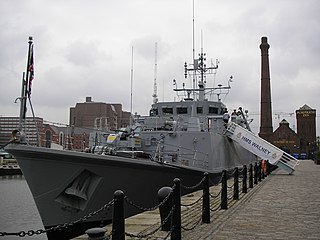
HMS Walney (M104) was a Sandown-class minehunter of the British Royal Navy. She was the fourth of the Sandown-class minehunters, and the second ship to carry the name, which comes from the island off Barrow-in-Furness in Cumbria on the north-west coast of England.

HMS Shoreham was a Sandown-class minehunter of the British Royal Navy. She was the fifth vessel to bear the name. From 2018 to 2021, Shoreham was deployed at UKNSF Bahrain together with three other mine countermeasures ships as part of 9 Mine Countermeasures Squadron on Operation Kipion. In 2022 she was decommissioned and was transferred to Ukraine.

The Moudge or Mowj is a class of domestically-produced Iranian light frigates.
Lobelia (M921) is a Tripartite-class minehunter of the Belgian Naval Component, launched on 3 February 1988 at the Mercantile-Belyard shipyard in Rupelmonde and christened by Anne Van De Kerckhof, the wife of the then Mayor of Diest, on 25 February 1989. The patronage of Lobelia was accepted by the city of Diest. It was the seventh of the Belgian Tripartite-class minehunters. The Belgian Naval Component announced on its website on 5 November 2007 that Mrs. Van De Kerckhof, the godmother of Lobelia, had died on 27 October. A delegation of the crew of Lobelia attended her funeral.

Gordi is a Wielingen-class frigate of the Bulgarian Navy with number 43. She was originally commissioned as Westdiep in the Belgian Navy.

The Lerici class is a class of minehunters constructed by Intermarine SpA and owned and operated by the Italian Navy. The class incorporates two subclasses: the first four ships are referred to specifically as the first series of the Lerici class, while eight more ships produced to a slightly modified design are known as "second series Lericis" or as the Gaeta class.
Tsibar is a Tripartite-class minehunter of the Bulgarian Navy. The ship was formerly Myosotis (M922) of the Belgian Naval Component. Myosotis' keel was laid on 6 July 1987 at Ostend yard of Beliard-Murdoch. She was launched on 4 August 1988 and completed on 14 December 1989. Myosotis was stricken from the Belgian Naval Component in 2004 and sold to Bulgaria.
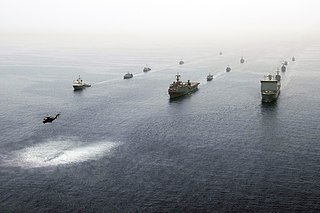
PNS Munsif (M166) is the lead ship of the Munsif-class minehunter currently in service with the Pakistan Navy.

Imanta (M-04) is the lead ship of the Tripartite class of minehunters for the Latvian Naval Forces. The vessel was formerly HNLMS Harlingen (M854), a Tripartite-class minehunter of the Royal Netherlands Navy built in 1984. Alkmaar and Imanta are, respectively, the Dutch and Latvian navies' names of the Tripartite class of minehunters, developed jointly by France, Belgium, and the Netherlands.

The Double Eagle is a remotely operated vehicle (ROV) built by the Swedish defence company Saab Underwater Systems AB and used for the disposal of naval mines.

The Netherlands and Belgium are doing a joint procurement for the replacements of the Tripartite-class/Alkmaar-class minehunters. Both countries want to procure six new mine countermeasure (MCM) vessels, which makes for a total of 12 MCM ships. The new MCM ships will include a range of unmanned systems including unmanned surface, aerial and underwater vehicles alongside towed sonars and mine identification and neutralization ROVs.

HNLMS Vlissingen (M840) is the second ship in the City / Vlissingen-class of mine countermeasures vessels, and first to be built for the Royal Netherlands Navy.
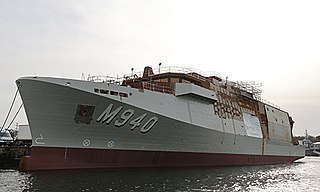
Oostende (M940) is the first ship in the City-class mine countermeasures vessels. She is being constructed in France for the Belgian Navy.

HNLMS Scheveningen (M841) is the fourth ship in the City / Vlissingen-class mine countermeasures vessels, and second to be built for the Royal Netherlands Navy.
















